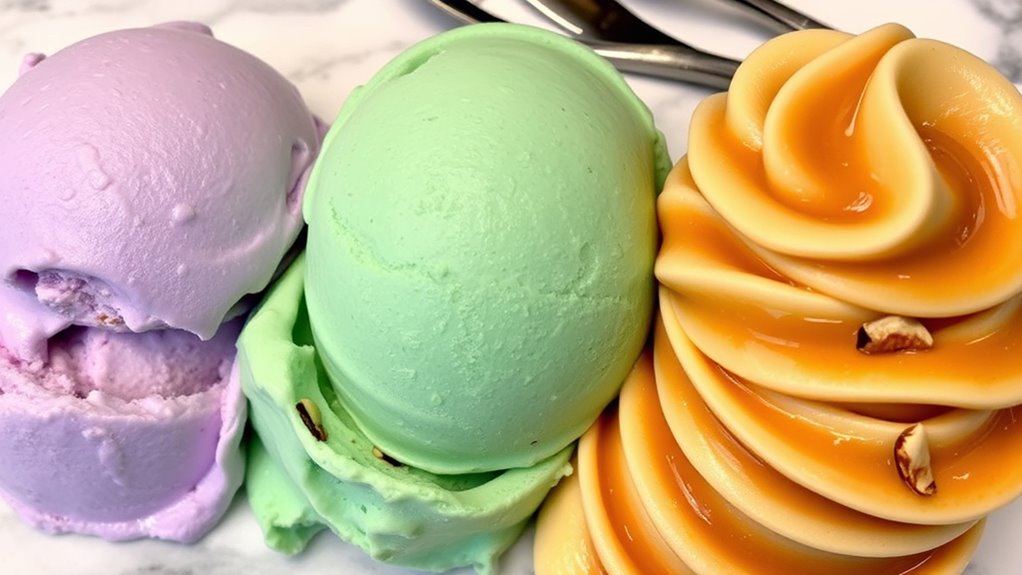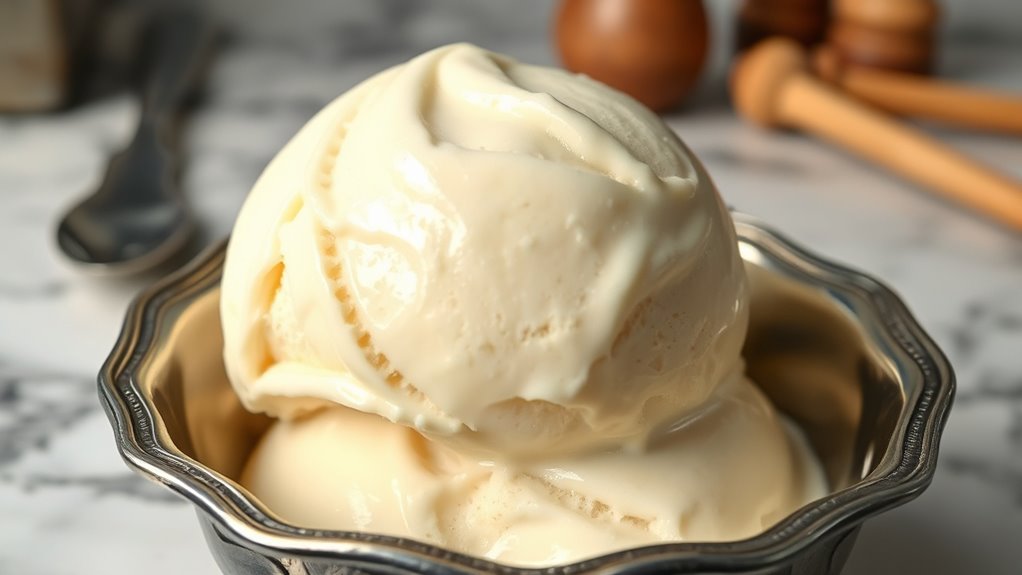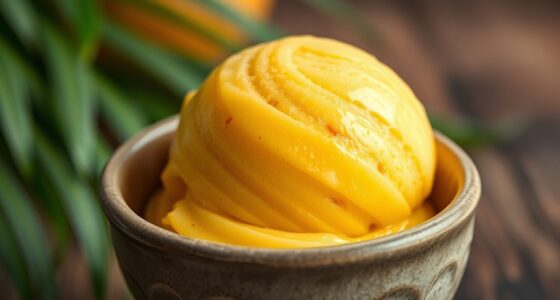French gelato-making techniques focus on precise temperature control, starting with a carefully cooked custard that’s heated gently and cooled quickly in an ice bath to prevent large ice crystals. Stabilizers like gelatin or starch are added to improve firmness and texture. For the best results, sometimes the custard is aged overnight. Mastering these methods guarantees a smooth, velvety gelato that’s consistently delicious—continue exploring to discover all the secrets behind these refined techniques.
Key Takeaways
- Precise temperature control during custard pasteurization and cooling ensures a smooth, velvety texture.
- Slow tempering of egg yolks with hot dairy prevents curdling and promotes uniform custard.
- Rapid cooling in an ice bath halts cooking and minimizes ice crystal formation for creaminess.
- Incorporation of stabilizers like gelatin or starch enhances structure and reduces melting.
- Aging the custard overnight deepens flavor and improves texture, characteristic of French gelato techniques.

French techniques in gelato making focus on creating a smooth, creamy texture through careful temperature control and precise preparation. Central to this process is the custard base, which combines egg yolks, milk, and cream. To guarantee safety and achieve the desired velvety consistency, you start by pasteurizing the mixture—heating it to about 85°C (185°F)—which kills bacteria while maintaining the custard’s richness. As you heat, it’s essential to stir constantly, preventing curdling and ensuring even heat distribution.
French gelato relies on precise temperature control and a rich custard base for a smooth, velvety texture.
Once pasteurized, the next step is tempering. You slowly add hot dairy to the egg yolks, gradually raising their temperature without scrambling them. This controlled process creates a stable mixture that, when cooked further, forms a smooth custard. You then cook the custard gently, stirring continuously until it thickens slightly. This step is critical for developing the creamy, velvety texture that characterizes French gelato.
Once cooked, you transfer the mixture to an ice bath immediately. This rapid cooling halts the cooking process, prevents over-thickening, and considerably reduces ice crystal formation, which can ruin the silky mouthfeel. Proper temperature control remains indispensable throughout. Using a thermometer, you monitor the mixture’s temperature during both heating and cooling stages to maintain ideal consistency.
Adding stabilizers such as gelatin or starch helps preserve the gelato’s structure by binding water and preventing large ice crystal formation during freezing. Proper chilling in the ice bath ensures the custard reaches the right coldness before churning. Some recipes recommend aging the custard overnight—this allows flavors to deepen and the mixture to stabilize further, enhancing the final texture.
To maintain firmness and reduce melting, especially in warmer environments, many French gelato recipes incorporate stabilizers such as gelatin or starch. Gelatin, often dissolved in a small amount of warm liquid, helps preserve the gelato’s structure by binding water and preventing large ice crystal formation during freezing. This results in a gelato that’s not only smooth but also holds its shape well.
The addition of stabilizers complements the natural richness of the custard base, guaranteeing a consistently creamy and firm product. Throughout the process, careful temperature control and precise timing are your best tools. These steps, combined with proper aging, stabilizer use, and rapid cooling, culminate in a gelato with a luxurious, velvety texture that melts beautifully on your tongue.
Mastering these French techniques guarantees your gelato will be smooth, stable, and full of flavor—just as it’s made in traditional French artisan kitchens.
Frequently Asked Questions
What Is French Style Ice Cream?
French-style ice cream, or crème glacée, is known for its rich, velvety texture. You make it by cooking a custard base with eggs, cream, and sugar, then chilling it thoroughly.
You need to carefully control the temperature to prevent curdling and achieve a smooth consistency. Using high-quality ingredients and precise techniques, including stabilizers if desired, helps you create an authentic, luxurious ice cream experience.
What Are Common Gelato Mistakes?
Did you know that improperly prepared gelato can turn grainy or rubbery? Common mistakes include using too high a temperature during custard prep, which causes curdling, and overmixing, leading to dense texture.
Not cooling the base quickly results in large ice crystals, and over-churning introduces excess air, making it overly fluffy. Paying attention to temperature, cooling, and churning process is essential for achieving perfect, creamy gelato every time.
How Do You Prevent Ice Crystals in Gelato?
To prevent ice crystals in gelato, you should add stabilizers like guar gum or carrageenan at about 0.3% of your mix. This helps inhibit crystal growth.
Make sure your base is thoroughly cooled below 50°F before freezing, and use rapid freezing methods such as a well-chilled ice cream maker or blast freezer.
Keep the gelato at low temperatures during storage and serve to avoid recrystallization, ensuring a smooth, creamy texture.
What Is the Base for French Style Ice Cream?
The base for French-style ice cream is a custard made from eggs, milk, cream, and sugar. You cook this mixture to about 170-180°F, reaching a nappe consistency that coats a spoon, ensuring proper pasteurization.
As you cook, the egg yolks act as natural emulsifiers, creating a smooth, velvety texture. After cooling quickly, you add flavorings like vanilla or fruit before churning to achieve that rich, creamy finish.
Conclusion
By mastering French techniques, you can elevate your gelato to a new level of richness and flavor. Did you know that France has over 38,000 artisanal ice cream and gelato shops, showcasing their passion for perfecting frozen treats? Incorporating these traditional methods allows you to create gelato with authentic textures and nuanced flavors. So, embrace these techniques, experiment boldly, and delight your customers with truly exceptional frozen desserts that reflect French craftsmanship.









